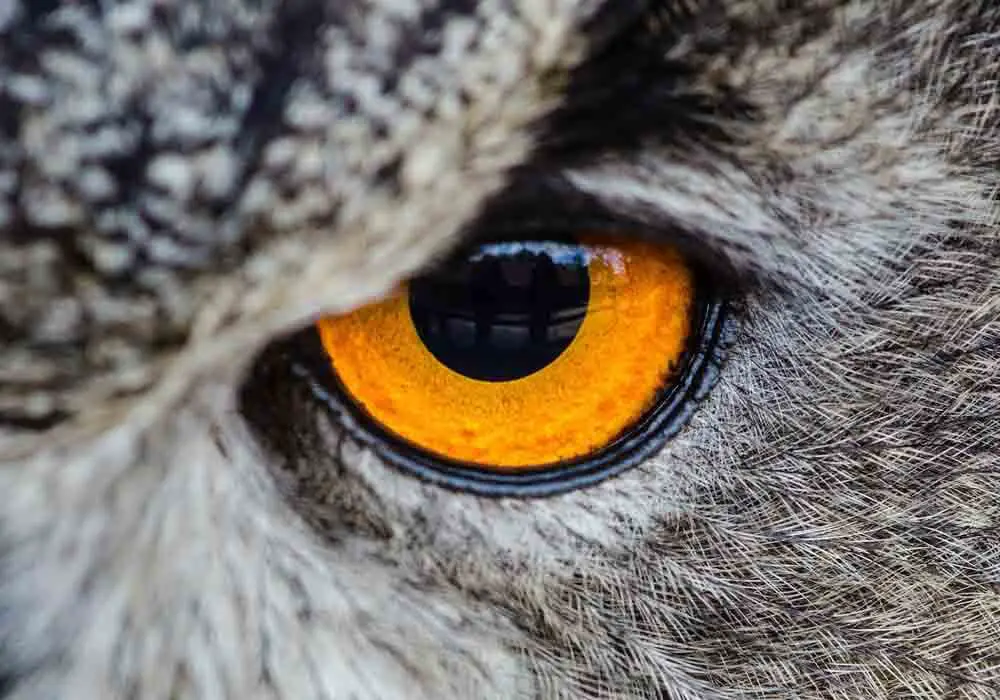Bird Vision
Just How Do Birds See The World?
While we dream of super eyesight, birds have beaten us at that race. Among animals, they are deemed to have the best sight, making bird vision a fascinating phenomenon to study.
Bird vision refers to the tetrachromatic visual system of birds. This optical system allows these creatures to distinguish colors better and even see colors we cannot perceive. Other anatomical adaptations also allow birds to see farther, underwater, and during the night.
Birds develop beyond incredible eyesight because they hunt from the sky. Through this article, you'll understand more about this extraordinary feat of theirs.

What Kind of Vision Do Birds Have?
Birds have tetrachromatic vision. This means they have a visual system with more cone types than other animals. Their vision can also be monocular or binocular.
Birds Have UV-Sensitive or Violet-Sensitive Tetrachromatic Vision
As humans, we have trichromatic vision. That means our eyes have three types of photoreceptors or light-sensitive cells. These cells can discern the three primary colors: red, green, and blue.
On the other hand, bird vision is tetrachromatic. Thus, besides the red, green, and blue colors, some can also perceive ultraviolet (UV) waves. That's pretty hard for us to imagine because we can't see them in the first place, but simply put, birds can see colors we can’t.
However, not all birds are great at perceiving UV light. There are two types of tetrachromatic visual systems: UV-sensitive and violet-sensitive.
Although violet and ultraviolet sit next to each other on the electromagnetic spectrum, these two types of visual systems still lead to birds perceiving colors differently, depending on whether they are UV-sensitive or violet-sensitive.
For instance, a study on bird-pollinated flowers shows that the flowers reflect colors or light depending on what their pollinating bird perceives best.
Those pollinated by violet-sensitive birds have an inflection point at 600 nm, while those visited by ultraviolet-sensitive birds have theirs at 416 nm. These inflection points correspond to wavelength areas where the birds could discern colors best.
Birds Can Either Be Monocular or Binocular
Besides being tetrachromatic, bird vision can also be monocular or binocular.
Humans have a binocular vision; that is, what our right eye sees is also what our left eye sees. This allows us to perceive depth, but we can't see much from the sides of our heads. Thus, our peripheral vision is pretty limited.
However, if you've observed a chicken, its eyes are on either side of its head. What its right eye sees is entirely different from what its left eye perceives.
Monocular eyes allow birds to have a broader field of view, so they can keep an eye out for predators (quite literally). However, they would have to turn their head side to side to fully gauge the depth of their environment.
Some birds that have binocular vision are hawks and owls. Binocular birds are mainly predatorial. They must perceive depth well to accurately pinpoint and swoop on their prey.
How Good Is Birds Eyesight?
As I've initially emphasized, birds have good, even excellent, eyesight. They can perceive more colors, discern details from great distances, and perform extraordinary visual feats.
Birds have such good eyesight they can see colors humans cannot, including ultraviolet (UV). Certain species, especially birds of prey, can discern details from distances as far as 20 feet (6.1 m). Some birds can also see underwater and during the night.
Although we can generally say that birds have excellent eyesight, their features and capabilities aren't uniform.
For instance, only certain bird species can see at night, such as owls. Their eyes have been specially adapted for the dark but not so much for the day.
Some have violet-sensitive visual systems, while others have UV-sensitive ones. Others may even have inactivated genes for specific photoreceptors, so they see fewer colors.
Compared to other animals, just how sharp is bird vision?
This video does a side by side comparison...so where do birds rank?
How Far Can Birds See?
Birds are known to fly thousands of feet above us. However, do we know how far they can see?
Birds can see as far as 2 miles (3.2 kilometers) to 3 miles (4.8 kilometers) away. Such ability is primarily observed in birds of prey, like eagles and falcons. This allows them to soar thousands of feet above the sea and still be able to detect and attack other creatures.
We must note that not all birds can see as far. Every species has its limitations; for certain birds of prey, it's 3 miles or 4.8 km away.
Birds of prey have extraordinary eyesight because they have an excellent visual acuity of 20/5. That means that at 20 feet away, they can distinguish an object's fine details that humans can only do so from 5 feet away.
Normal human visual acuity is 20/20. Variations in that value may lead to some of us needing glasses to see better.
Moreover, some birds can have a field of view of more than 300 degrees. Thus, they can see details from the sides of their heads, which humans normally could not.
Bird Vision vs. Human Vision
How are birds able to have such extraordinary vision?
That's mainly because they evolved to be so. There are many adaptations present only in birds that humans and other animals don't have, and these adaptations allow birds to have excellent eyesight.
I've outlined some significant differences and adaptations in the table below.
|
Characteristic |
Bird Vision |
Human Vision |
|
Visual system |
Tetrachromatic |
Trichromatic |
|
Monocular/Binocular |
Monocular or binocular |
Binocular only |
|
Number of eyelids |
Three |
Two |
|
Corneas can focus |
Yes |
No |
|
Density of photoreceptors |
High |
Low |
|
Density of cone cells |
Typically high |
Low |
|
Eye size |
Large |
Small |
|
Number of fovea |
Some have two |
One only |
|
Oil droplets |
Present |
None |
Visual System
The tetrachromatic system of birds lets them see other colors besides those in the visible light spectrum.
For instance, some species (to us) look like they have males and females of the same color. But to birds, the ability to see UV lets them see that there are stark differences between the two sexes. Their males may have plumage that reflects UV, while the females don't.
However, not all birds have a tetrachromatic system or four types of photoreceptors. Most nocturnal birds, like the tawny owl, have three of them only.
Number of Eyelids
Birds can have a functional third eyelid called the nictitating membrane. It protects the eyes horizontally.
Birds with transparent nictitating membranes can see underwater as this eyelid protects the eye from water while remaining open. It's like an inbuilt underwater contact lens or swimming goggles.
Interestingly, mammals like humans do have nictitating membranes. However, it's now in a reduced and non-functional form. In humans, it appears as the pink corners of our eyes.
Corneas Can Focus
Humans have a set of muscles that help control the lens's shape, which gives us the ability to focus. However, birds have an extra set of muscles that control the cornea.
Thus, they can concentrate through two ways — lens and cornea. The ability to focus the lens comes in handy underwater.
Density of Photoreceptors
Compared to humans, birds have a high density or more photoreceptors than humans. Because photoreceptors detect and transmit light signals to the brain, the more an animal has, the better it can see.
It's like how a smartphone camera with a higher megapixel resolution takes better pictures than others.
Density of Cone Cells
Photoreceptor cells can either be cones or rods.
Cones are associated with processing colors. They are activated under high light conditions and allow our eyes to discern between fine details. The types of cones determine what colors an animal can see.
Birds have four types of cone cells, so they can also see UV. Not only do they have more classes, but they also typically have a more significant number of cone cells. Thus, they can process colors better.
I say typically because nocturnal birds like owls have adapted to have more rods than cones. The former cells are crucial for dim light vision, which owls need. However, rods perceive monochromatic colors only.
Eye Size
Birds have the most prominent eyes relative to their body size. The larger surface area allows for a higher density of photoreceptor cells. As I've mentioned, the more photoreceptors, the better because they receive and process light signals.
Moreover, a larger eye size (specifically a larger cornea) allows nocturnal vision. The larger surface area collects as much light as possible.
Nocturnal birds also have a tapetum lucidum in the back of their eye, improving their light-gathering ability. This part also makes their eyes (and other animals' eyes, like cats) shine at night.
Birds of prey also have relatively large eyes. This allows them to have better resolution.
Number of Fovea
There is an area in the retina's center where the photoreceptors are at their densest. This area is called the fovea. Human eyes typically have only one fovea.
However, some birds can have two. This allows certain species to process images from both the front and sides of their head. Thus, they have great forward and peripheral vision.
Oil Droplets
Birds are also known to have oil droplets in their cone cells. These droplets help filter light about to be received by cone cells. Specifically, they shift the cells' peak wavelengths to a longer length. This improves resolution as the intersection between cone types or classes is reduced.
Bird Vision...Some Final Thoughts
Bird vision has often amazed humans. It’s not only the superior eyesight that mesmerizes us but also the intricate system of adaptations and mechanisms that make it possible. Although we have discovered a significant portion of how bird vision works, we are yet to unlock all of its wonders.

Bird vision is but one sense they posess. Here are a few other articles of ours that we think you'll find fascinating...
Bird Senses...we cover all of their senses in depth
What Can Birds Smell?...just how sensitive is it?
Can Birds Sense Danger?...if so, how?
Back
To The TOP Of This Bird Vision Page

About the Author...
Richard Worden, a dedicated bird lover for over 20 years, I love to share my in-depth knowledge and passion for birds. Read more About Me and my expertise in this field.
- We Know Birds HOME ›
- Bird Senses and How They Use Them ›
- Bird Vision
